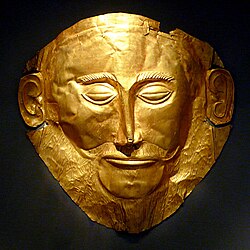Mask of Agamemnon

The mask in its current location
|
|
| Material | Gold |
|---|---|
| Created | 1550–1500 B.C. |
| Discovered | 1876 at Mycenae, Greece by Heinrich Schliemann |
| Present location | National Archaeological Museum, Athens |
The Mask of Agamemnon is an artifact discovered at Mycenae in 1876 by Heinrich Schliemann. It has been referred to as the "Mona Lisa of prehistory"
The artifact is a funeral mask made in gold, and was found over the face of a body in a burial shaft, designated Grave V, at the site "Grave Circle A, Mycenae".
Schliemann believed that he had discovered the body of the legendary Greek leader Agamemnon, naming his son after him in 1878, but modern archaeological research suggests that the mask is from 1550–1500 BCE—earlier than the life of Agamemnon, as tradition regards it. The mask is currently displayed in the National Archaeological Museum of Athens.
The mask is one of five discovered in the royal shaft graves at Mycenae—three in Grave IV and two in Grave V. The faces and hands of two children in Grave III are covered with gold leaf, one covering having holes for the eyes. The mask was designed to be a funeral mask covered in gold.
The faces of the men are not all covered with masks. That they are men and warriors is suggested by the presence of weapons in their graves. The quantities of gold and carefully worked artifacts indicate honor, wealth and status. The custom of clothing leaders in gold leaf is known elsewhere. The Mask of Agamemnon was named by Schliemann after the legendary Greek king of Homer's Iliad. This mask adorned one of the bodies in the shaft graves at Mycenae. Schliemann took this as evidence the Trojan War was a real historical event.
The mask of Agamemnon was created from a single thick gold sheet, heated and hammered against a wooden background with the details chased on later with a sharp tool.
In the later half of the 20th century and the beginning of the 21st century, the authenticity of the mask has been formally questioned, primarily by William Calder III and David Traill.Archaeology magazine has run a series of articles presenting both sides of the debate. By the time of the excavation of the Shaft Graves, the Greek Archaeological Society had taken a hand in supervising Schliemann's work (after the issues at Troy), sending Panagiotis Stamatakis as ephor, or director, of the excavation, who kept a close eye on Schliemann.
...
Wikipedia
